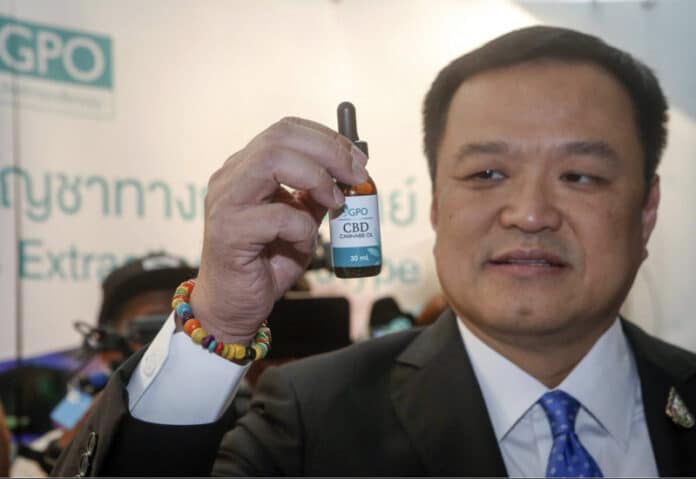
Policy to allow every Thai household to grow six marijuana plants for sale to the government is starting to take root
Thailand has built what’s being described as the biggest industrial-scale medical marijuana facility in Southeast Asia with 12,000 plants under cultivation, and will soon allow all Thais to grow six cannabis plants “in their back gardens like any other herb.”
Recreational marijuana use remains illegal in the kingdom, with punishments including imprisonment. Enthusiasts hope the evanescing resistance to medical marijuana will eventually result in looser laws for public puffing enjoyment and business profits.
Those changes appear to be gaining momentum. On September 2, government officials attended a ceremony in northern Thailand’s Chiang Mai where Maejo University researchers planted 12,000 new marijuana sprouts.
The promising shoots are being grown inside a newly built 3,040-square meter greenhouse with controls for temperature, moisture and light. Seeds for the 12,000 plants were provided by the government’s Department of Medical Service.
Officials expect the plants will produce medical-grade cannabis flowers and buds within six months.
The Government Pharmaceutical Organization (GPO) hopes to use those ingredients to make one million bottles of cannabis oil, each containing five milliliters, by February 2020.
“These are historic first steps on the path towards allowing people to grow six cannabis trees in their homes,” said newly appointed Health Minister Anutin Charnvirakul. “In the near future, families will be able to plant it in their back gardens like any other herb.
“The university will be a center where ordinary people can learn how to plant and grow good quality cannabis. Cannabis is not an issue of politics, it is a product that can benefit people’s health,” he said, planting a sprout while wearing a white lab coat.
Anutin led his middle-sized Bhumjaithai (Proud to be Thai) party’s campaign earlier this year during parliamentary elections by promising each household could grow six marijuana plants. By selling each mature plant to the government for $2,225, a family could earn $13,350 for all six, he told voters.
Foreign experts warn not every plant produces medical-grade cannabis, and the ones that do are difficult to raise. Amateurs could produce average weed, but without investing money and taking time to tend to the plants, those crops would not qualify for the government to purchase for medical use, they say.
If recreational marijuana is allowed, however, then private growers could make easier profits because quality requirements would be less strict.
Anutin predicted fully legalized marijuana would be a bigger and more lucrative crop for Thailand than rice, sugarcane, tapioca, rubber or other produce in this mostly agrarian nation.
He has suggested Thailand’s low wages would boost its competitiveness in international markets vis-a-vis big foreign cannabis companies where operating costs are higher.
Potential up-and-coming rivals in Latin America, Africa and elsewhere in Asia, however, could outgrow Thailand, which would need to create niche strains to sell abroad, foreign experts said.
Maejo University has reportedly developed a marijuana strain it calls “Issara” (independence), which offers equal percentages of cannabidiol (CBD) and tetrahydrocannabinol (THC).
Future strains will offer differing percentages of CBD and THC to treat illnesses and symptoms requiring other ratios, the university’s researchers say. Officials hope more Thai universities, labs, agricultural experts and botanists will produce additional local strains.
“We have plans to extend the cannabis-growing to outdoor areas too, which is likely to be suitable for the local strains that are found in many parts of the country,” director of the Maejo Natural Farming Research and Development Center said, according to local media.
At least 13 hospitals have reportedly received licenses to dispense cannabis extracts to patients with prescriptions. A classroom inside a hospital in Pranchinburi province recently began teaching the public how to grow medical-grade marijuana.
“This training course consists of both classroom lectures and practical sessions in closed-farming plots,” Chaophraya Abhaibhubejhr Hospital’s director Namphol Danpipat said on September 17.
“We aim to provide students with optimal growing techniques that will yield the best quality cannabis for medical purposes,” Namphol said according to local media.
The training course was titled: “Medical Cannabis Organic Farming for Agriculturists and the General Public.”
Teachers will instruct students on how patients can use CBD and THC, how to prevent fungus and pest damage, and what government regulations must be obeyed to produce marijuana for medical use.
Thais have been growing weed for hundreds of years for traditional purposes including to treat illnesses, relaxation, recipes and entertainment. Strict medical quality is a new concept, though.
Thailand’s legendary, mind-bending “Thai Stick” strain of illegal weed was hailed among the US and international counterculture during the 1960s and 70s. But it was rarely developed into better strains with varying percentages of ingredients.
Countless other strains have been developed during recent years in the US, Canada, Europe and other mostly Western countries.
As a result, Thailand lags behind other countries where medical and recreational marijuana has been legalized and developed to produce an array of foreign strains with CBD and THC levels suitable for medical use.
“Most Thai marijuana strains contain more THC than CBD, which makes them more suitable for recreational use,” GPO director Withoon Danwiboon said in May.
Concerned about foreign competition, Thailand approved a US$4 million budget in August to expand government-controlled marijuana farms for medical purposes.
Last month, Thailand announced that its first relatively small pharmaceutical laboratory produced CBD and THC oils, tablets, oral sprays, chocolate wafers and traditional potions for medical use. They proudly displayed the lab’s tiny but potent garden of 72 plants.













